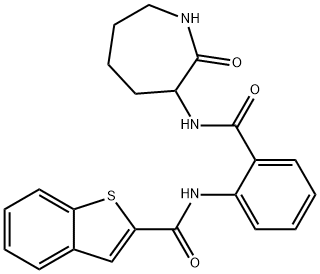ANA-12 is a selective TrkB antagonist with Kd of 10 nM and 12 μM for the high and low affinity sites, respectively.
ANA-12 binds directly and selectively to TrkB and inhibits processes downstream of TrkB without altering TrkA and TrkC functions. In nnr5 PC12-TrkB cells, ANA-12 prevents brain-derived neurotrophic factor (BDNF)-induced neurite outgrowth at concentrations as low as 10 nM. In DRG neurons, ANA-12 eliminates the effect of BDNF on increasing inward current.
In adult C57BL6/129SveV F1s mice, ANA-12 (0.5 mg/kg, i.p.) decreases TrKB activity in the brain and reduces the anxiety- and depression-related behaviors without affecting the neuron survival. In male C57BL/6 mice, ANA-12 (0.5 mg/kg, i.p.) shows antidepressant-like effects on lipopolysaccharide-induced depression-like behavior. In male Sprague-Dawley rats, ANA-12 (3 μg/dose) blocks the effect of medial nucleus tractus solitarius (mNTS) BDNF on reducing food intake. In male wild-type mice, ANA-12 reverses ethanol intake and induces D3 receptor downregulation, but is ineffective in D3R-/- mice. In male CocSired rats, ANA-12 (0.5 mg/kg, i.p.) reverses the diminished self-administration of cocaine.
ANA-12 (219755-25-3) is a TrkB receptor antagonist. Binds to two distinct receptor sites preventing activation by BDNF non-competitively, IC50?= 45.6 nM and 41.1 μM for the high and low affinity sites respectively. Systemic administration to adult mice decreased TrkB activity in the brain without affecting neuronal survival or altering TrkA and TrkC functions. ANA-12 displays antidepressant and anxiolytic properties in mouse models after systemic administration.1?Shows antidepressant effects on LPS-induced depression-like behavior in mice.2?ANA-12 has been used to elucidate the role of BDNF in improvement of cognitive decline during calorie restriction3?and in the discovery of new neurotrophic agents4.
ANA-12 was used to inhibit TrkB in primary mouse cortical neurons and primary rat hippocampal cultures.
ChEBI: ANA-12 is a secondary carboxamide that is anthranilic acid in which the carboxy group has undergone condensation with the primary amino group of alpha-amino-epsilon-caprolactam, while the aryl-amino group has undergone condensation with the carboxy group of 1-benzothiophene-2-carboxylic acid. It is a selective, non-competitive antagonist of tropomyosin receptor kinase B (TrkB, also known as tyrosine receptor kinase B). It has a role as a tropomyosin-related kinase B receptor antagonist, an antidepressant and an anxiolytic drug. It is a secondary carboxamide, a member of caprolactams and a member of 1-benzothiophenes. It is functionally related to a 2-aminohexano-6-lactam and an anthranilic acid.
The neurotrophin brain-derived neurotrophic factor (BDNF) and its receptor tropomyosin-related kinase B (TrkB) have emerged as key mediators in the pathophysiology of several mood disorders, including anxiety and depression. ANA-12 is a TrkB ligand that prevents activation of the receptor by BDNF with a high potency. It binds selectively to TrkB and inhibits processes downstream of TrkB without altering TrkA and TrkC functions. In adult mice model ANA-12 decreases TrkB activity in the brain without affecting neuronal survival. Mice dosed with ANA-12 show reduced anxiety- and depression related behaviors on a variety of tests predictive of anxiolytic and antidepressant properties in humans. ANA-12 may be a valuable tool for studying BDNF/TrkB signaling and may constitute a lead compound for developing the next generation of therapeutic agents for the treatment of mood disorders. There is also N-T19, which is less potent.
1) Cazorla?et al. (2011),?Identification of a low-molecular weight TrkB antagonist with anxiolytic and antidepressant activity in mice; J. Clin. Invest.,?121?1846
2) Zhang?et al. (2014),?Antidepressant effects of TRKB ligands on depression-like behavior and dendritic changes in mice after inflammation; J. Neuropsychopharmacol.,?18?pyu077
3) Kishi?et al. (2015),?Calorie restriction improves cognitive decline via up-regulation of brain-derived neurotrophic factor: tropomyosin-related kinase B in hippocampus of obesity-induced hypertensive rats; Int. Heart J.,?56?110
4) Chakravarty?et al.?(2015) A?novel natural product inspired scaffold with robust neurotrophic, neurogenic and neuroprotective action; Sci. Rep.,?5?14134


